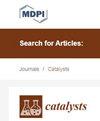对镍引发的乙烯基环丙烷与 N-对甲苯磺酰基苯甲醛二胺之间 [3+2] 环加成反应的机理、区域/非对映选择性和配体作用的深入了解
IF 3.8
3区 化学
Q2 CHEMISTRY, PHYSICAL
引用次数: 0
摘要
采用密度泛函理论(DFT)探讨了膦配体辅助下镍引发的乙烯基环丙烷(VCP)与 N-对甲苯磺酰基苯甲醛二胺之间的[3+2]环加成反应机理、区域选择性和非对映选择性。在 VCP 的开环过程中,探索了镍中心与 VCP 底物的四种不同结合模式,其中 C,C_anti 和 C,C_syn 模式被证实是最容易结合的模式。根据两种最可能的结合模式对四种不同的膦配体辅助反应进行的进一步探索表明,双齿和单齿膦配体结合模式的不同会改变最佳反应途径,特别是在开环中间体与 N-对甲苯磺酰基苯甲醛二胺之间的 [3+2] 环加成反应过程中。研究发现,N-对甲苯磺酰基苯甲醛二胺与开环中间体通过[3+2]环化反应形成 C-C 键和 C-N 键的过程是逐步进行的,在大多数情况下,前者是决定反应速率的步骤(RDS)。在最佳路径 I 或 II 上计算的 RDS 过渡态自由能垒不仅能很好地预测反应速率和半衰期,还能合理解释顺式吡咯烷的主要生成原因。对关键静止点的非共价相互作用分析表明,反应速率受电子效应和立体阻碍的影响,而非对映选择性则主要受电子效应的控制。本文章由计算机程序翻译,如有差异,请以英文原文为准。
Insights into the Mechanism, Regio-/Diastereoselectivities and Ligand Role of Nickel-Initiated [3+2] Cycloadditions between Vinylcyclopropane and N-Tosylbenzaldimine
Density functional theory (DFT) was employed to explore the reaction mechanism, regio- and diastereoselectivities of nickel-initiated [3+2] cycloaddition between vinylcyclopropane (VCP) and N-tosylbenzaldimine assisted by phosphine ligands. Four different binding modes of the nickel center to VCP substrate were explored during the ring-opening of VCP, among which the C,C_anti and C,C_syn modes were verified to be the most accessible ones. Further explorations about four different phosphine ligand-assisted reactions based on the two most probable binding modes show that the difference in binding mode of bi- and monodentate phosphine ligands can vary the optimal reaction pathway, especially in the [3+2] cycloaddition process between the ring-opened intermediate and N-tosylbenzaldimine. The formation of C–C and C–N bonds between N-tosylbenzaldimine and the ring-opened intermediate through [3+2] cycloaddition is found to be stepwise, with the former acting as the rate-determining step (RDS) in most cases. Computed free energy barriers of RDS transition states on the optimal path I or II not only give out good predictions for reaction rates and half-lives, but also provide reasonable explanations for the major generation of cis-pyrrolidine. Noncovalent interaction analyses of key stationary points suggest the rate is influenced by both electronic effects and steric hindrance, while the diastereoselectivity is mainly controlled by electronic effects.
求助全文
通过发布文献求助,成功后即可免费获取论文全文。
去求助
来源期刊

Catalysts
CHEMISTRY, PHYSICAL-
CiteScore
6.80
自引率
7.70%
发文量
1330
审稿时长
3 months
期刊介绍:
Catalysts (ISSN 2073-4344) is an international open access journal of catalysts and catalyzed reactions. Catalysts publishes reviews, regular research papers (articles) and short communications. Our aim is to encourage scientists to publish their experimental and theoretical results in as much detail as possible. Therefore, there is no restriction on the length of the papers. The full experimental details must be provided so that the results can be reproduced.
 求助内容:
求助内容: 应助结果提醒方式:
应助结果提醒方式:


